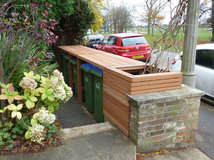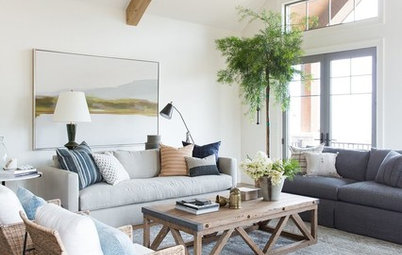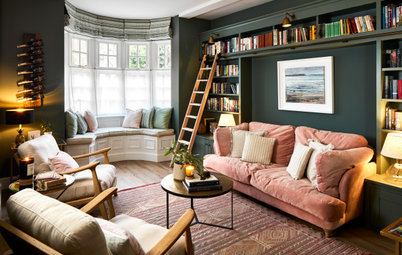Small Space Living: 9 Common Mistakes to Avoid When Space is Tight
Dodge the classic pitfalls of designing a small space and make the most of the room you have with these smart ideas and solutions
Jo Simmons
28 November 2015
Houzz UK Contributor. I have been an interiors journalist since 1995, writing several books on design and numerous features for glossy homes mags over the years. For Houzz, I cover decorating ideas and trends and interview designers and professionals for their insights. My favourite pieces to write, though, are Houzz Tours, as I love exploring and learning about real homes. Call me curious — or nosy!
Houzz UK Contributor. I have been an interiors journalist since 1995, writing several... More
From a pocket-sized room or super-small studio flat to a whole house that’s more snug than spacious, tackling a tiny space demands thought, care and creativity. While big homes and generous rooms can be more forgiving and offer at the very least abundant floor space, a tiny room or flat is less flexible and needs to work harder. Get it right, though, and its beauty and functionality will outshine its size.
Check out this roundup of nine mistakes frequently made in a small space, with helpful solutions and tips for avoiding each one.
Check out this roundup of nine mistakes frequently made in a small space, with helpful solutions and tips for avoiding each one.
Pitfall No 1: Neglecting to plan
Kitting out your small home without first scrutinising it and making a smart plan is a mistake. It’s worthwhile sitting down with a floor plan and some scale furniture to test layouts. Your existing pieces may be wrong for a very small home, and it might be good to think about investing in compact furniture or pieces that can multi-task.
Take time to play around with ideas and remember that your first instincts on where to put furniture or how to configure the space could be wrong. The best solution will probably need some careful planning.
Kitting out your small home without first scrutinising it and making a smart plan is a mistake. It’s worthwhile sitting down with a floor plan and some scale furniture to test layouts. Your existing pieces may be wrong for a very small home, and it might be good to think about investing in compact furniture or pieces that can multi-task.
Take time to play around with ideas and remember that your first instincts on where to put furniture or how to configure the space could be wrong. The best solution will probably need some careful planning.
Pitfall No 2: Forgetting about volume and focusing on footprint
When the footprint is tiny, it’s crucial to think about the overall volume of a space instead. This means looking upwards and working out how to increase the feeling of space using what you have.
Raising a ceiling could gain you a mezzanine floor, as seen in the previous image, or it could expose roof beams, which will give a tiny space a feeling of generosity and loftiness. Installing skylights or sliding doors will max the light, which can also seem to expand a tiny area.
When the footprint is tiny, it’s crucial to think about the overall volume of a space instead. This means looking upwards and working out how to increase the feeling of space using what you have.
Raising a ceiling could gain you a mezzanine floor, as seen in the previous image, or it could expose roof beams, which will give a tiny space a feeling of generosity and loftiness. Installing skylights or sliding doors will max the light, which can also seem to expand a tiny area.
Pitfall No 3: Not maximising storage space
Storage is essential in any home, but in a small place, where and how you install it is crucially important to your home’s overall functionality.
It’s vital to make use of both vertical and wasted areas, so exploit the space under the bed, behind or above doors or high up. Building bespoke solutions is one route, but stalwarts of the storage world, from shelves to rails, hooks to ceiling clothes airers, will all help.
See 10 creative ways with hooks and hangers
Storage is essential in any home, but in a small place, where and how you install it is crucially important to your home’s overall functionality.
It’s vital to make use of both vertical and wasted areas, so exploit the space under the bed, behind or above doors or high up. Building bespoke solutions is one route, but stalwarts of the storage world, from shelves to rails, hooks to ceiling clothes airers, will all help.
See 10 creative ways with hooks and hangers
Pitfall No 4: Breaking up the space too much
Avoid visually breaking up the space too much as this can make it feel compartmentalised and even smaller than it is. Use room dividers, different flooring and wall colours, and even rugs with caution, and consider continuing the key ingredients throughout the home. An expanse of the same flooring or paint shade will give a sense of flow, opening out the space.
Avoid visually breaking up the space too much as this can make it feel compartmentalised and even smaller than it is. Use room dividers, different flooring and wall colours, and even rugs with caution, and consider continuing the key ingredients throughout the home. An expanse of the same flooring or paint shade will give a sense of flow, opening out the space.
Pitfall No 5: Failing to use mirrors
In a compact space, mirrors are your friends, so remember to work some in. They can really boost the feeling of space and bounce light around. Hang a framed mirror or go bespoke, fitting mirrored panels to sections of your wall.
If you like the space-boosting effect of mirrors but don’t want to be confronted with your reflection at every turn, fit them in the upper third portion of the room, as in this bedroom.
In a compact space, mirrors are your friends, so remember to work some in. They can really boost the feeling of space and bounce light around. Hang a framed mirror or go bespoke, fitting mirrored panels to sections of your wall.
If you like the space-boosting effect of mirrors but don’t want to be confronted with your reflection at every turn, fit them in the upper third portion of the room, as in this bedroom.
Pitfall No 6: Avoiding bold colours
Of course, light colours are brilliant at visually expanding a space and making it feel bigger than it really is. But that doesn’t mean you should avoid using dark colours altogether. A bold shade can have a huge impact in a small area and go a long way to creating a look for the entire home.
Painting walls a strong shade or installing colourful units, as here, is also a great way to introduce personality into a space without adding ‘stuff’ that will clutter it up.
Check out 10 beautiful kitchens in deliciously dark shades
Of course, light colours are brilliant at visually expanding a space and making it feel bigger than it really is. But that doesn’t mean you should avoid using dark colours altogether. A bold shade can have a huge impact in a small area and go a long way to creating a look for the entire home.
Painting walls a strong shade or installing colourful units, as here, is also a great way to introduce personality into a space without adding ‘stuff’ that will clutter it up.
Check out 10 beautiful kitchens in deliciously dark shades
Pitfall No 7: Playing by the rules
There are certain theories and rules that seem to circulate around small space living. The idea that building in multi-tasking furniture is essential – bench seating that has storage inside, for example – or sticking to a pale colour scheme.
The fact is, every home is individual and what works in one may not work in yours, so scrutinise every suggestion for improving a small space and feel free to ignore it, tweak it or change things back if they don’t work for you.
There are certain theories and rules that seem to circulate around small space living. The idea that building in multi-tasking furniture is essential – bench seating that has storage inside, for example – or sticking to a pale colour scheme.
The fact is, every home is individual and what works in one may not work in yours, so scrutinise every suggestion for improving a small space and feel free to ignore it, tweak it or change things back if they don’t work for you.
Pitfall No 8: Using furniture with the wrong proportions
Getting the size of your pieces right when space is limited is important. This doesn’t automatically mean you should use small items, though. Often, compact pieces seem to accentuate the mini dimensions of the room, while a big piece can look inviting and surprising.
A large upholstered sofa in a small living room, as here, can look really cosy, for example, whereas a tiny, wooden-framed seat could look mean and lost.
Consider shape, too. A circular table may be easier to shimmy around in a compact dining area, but then again, a long, slim table that can be pushed against the wall when not in use may work well in narrow room.
Getting the size of your pieces right when space is limited is important. This doesn’t automatically mean you should use small items, though. Often, compact pieces seem to accentuate the mini dimensions of the room, while a big piece can look inviting and surprising.
A large upholstered sofa in a small living room, as here, can look really cosy, for example, whereas a tiny, wooden-framed seat could look mean and lost.
Consider shape, too. A circular table may be easier to shimmy around in a compact dining area, but then again, a long, slim table that can be pushed against the wall when not in use may work well in narrow room.
Pitfall No 9: Owning too much stuff
You may be a hoarder at heart, but when living in a compact home, that instinct to acquire needs to be curbed! Having lots of anything, whether it’s crockery and pans or art and furniture, won’t work in a tiny home, so try paring back and see how much more airy and open the space feels.
Discover ingenious storage ideas for small spaces
TELL US…
Have you made any mistakes in a small home? Or discovered any brilliant solutions? Please share your advice and photos in the Comments below.
You may be a hoarder at heart, but when living in a compact home, that instinct to acquire needs to be curbed! Having lots of anything, whether it’s crockery and pans or art and furniture, won’t work in a tiny home, so try paring back and see how much more airy and open the space feels.
Discover ingenious storage ideas for small spaces
TELL US…
Have you made any mistakes in a small home? Or discovered any brilliant solutions? Please share your advice and photos in the Comments below.
Related Stories
Wellbeing
How to Improve the Air Quality in Your Home
Want to ensure your home environment is clean and healthy? Start by assessing the quality of your air
Full Story
Wellbeing
How to Prepare Your Home for Summer Heat
Check out these updates that will ensure your property is ready for hotter days
Full Story
Professional Advice
10 Tips for Choosing the Perfect Bed Linen
Should you pick crisp cotton or rumpled linen – and does thread count really matter? Bed linen can be baffling – here's all you need to know
Full Story
Renovating
How Can You Carve Out a New Room Without Extending?
By Kate Burt
When it comes to creating extra room, a mezzanine can be your best friend, cannily boosting space without the need for permission
Full Story
Renovating
Best of Houzz 2024: The Winning Design Projects
The Best of Houzz 2024 award winners have been announced. Take a look at some of the winning designs
Full Story
Redefining Design
A Room-by-room Guide to Inclusive Design
By Kate Burt
What is inclusive design – and why is it important for all our homes if we want them to be truly sustainable?
Full Story
Kitchens
How to Design a Multigenerational Kitchen
A space that successfully meets the needs of all those who use it is not only inclusive, it’s futureproof
Full Story
Renovating
How to Cut the Cost of Your Extension Project
Stay on budget when planning and building your extension with these expert tips for keeping costs down
Full Story
Most Popular
How to Survive a Major Building Project
By Eva Byrne
Get expert tips for improving your home while preserving your sanity
Full Story
Pets
Expert Ways to Integrate Your Dog’s Bed into Your Home
Good design can help to create the perfect home for you, but also a cosy spot for Fido to rest his weary paws
Full Story


































@teenytinyhouse, no, no space for a tiny shed, let alone a shed big enough to do real woodwork in (remember you have to be able to manoeuvre your pieces of wood around to machines. Ideally a thicknesser/plane and a saw table are needed to start with and then there are always a load of other tools - and this is for wood, then there are metal working tools.
I can work on the driveway, part of which is covered, but I can't buy tools such as listed above as I have nowhere to keep the larger ones when not in use. Such are the issues associated with living in a capital city. I am lucky to have any outdoor space really.
Love designing small. It really focuses the mind. There are lots of tricks to help with hte functionality of space, which can add plenty of character.